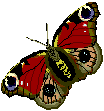 ...Butterfly
Farming Information
...Butterfly
Farming Information
The Painted Lady Butterfly (Vanessa cardui) is one of the most common butterflies in the world. Because of its wide range, it is sometimes called the "Cosmopolitan." It is a migratory species. The Painted Lady will undergo its complete life cycle under controlled conditions in the classroom. The four distinct stages of the life cycle (egg, larva, chrysalid, and adult) are easily observed.
In nature, each larva (caterpillar) builds a webbed nest on mallow or hollyhock, its natural host plant. The mature larva has a black body with a yellow stripe on each side and is about 1 1/2 inches long. The larva hangs from a stem or from the under surface of a leaf as the golden brown chrysalid develops.
The upper surface of the body and wings of the adult butterfly is mostly black, brown, and orange. There are also some white spots and red and blue markings. The underside of the adult is gray with white and red markings.
CULTURE
Set the vial containing the larvae in a well-lighted area where the temperature remains between 22 to 25 degrees C. DO NOT set the vial in direct sunlight.
In 5 to 10 days, the larvae will crawl to the top of the vial and hang from the filter paper. Each larva is preparing to form a chrysalid and should not be disturbed for 1 or 2 days. After the chrysalids have developed, place the filter paper with the insects attached in a cage (use an empty covered terrarium or similar container of approximately 1 to 2 cubic feet in volume). Adult butterflies should emerge 7 to 10 days later.
Prepare a 5 percent solution of sugar or honey in water. Pour about 1/2 ounce of this solution into a 1 ounce bottle. Roll up a small piece of paper towel and push it into the bottle until it extends about 1 centimeter into the solution. About 1 or 1 1/2 cm of the towel should protrude from the bottle. The towel forms a wick on which the butterflies can feed. Also place leaves, stems, or seedlings of mallow or hollyhock in the butterfly cage.
From 5 to 7 days after emergence, female butterflies should begin to deposit eggs on the host plants. The eggs are small, pale green spheres with 12 to 14 longitudinal ridges. They should begin to hatch after 3 to 5 days.
 ... Butterfly WebSite
Home Page
... Butterfly WebSite
Home Page
 Last Updated: April 30, 1997: butterfly@mgfx.com
Last Updated: April 30, 1997: butterfly@mgfx.com